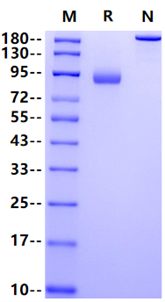Gly24-Gly458, with C-terminal Human IgG1 Fc GTLPKPTLWAEPASVIARGKPVTLWCQGPLETEEYRLDKEGLPWARKRQNPLEPGAKAKFHIPSTVYDSAGRYRCYYETPAGWSEPSDPLELVATGFYAEPTLLALPSPVVASGGNVTLQCDTLDGLLTFVLVEEEQKLPRTLYSQKLPKGPSQALFPVGPVTPSCRWRFRCYYYYRKNPQVWSNPSDLLEILVPGVSRKPSLLIPQGSVVARGGSLTLQCRSDVGYDIFVLYKEGEHDLVQGSGQQPQAGLSQANFTLGPVSRSHGGQYRCYGAHNLSPRWSAPSDPLDILIAGLIPDIPALSVQPGPKVASGENVTLLCQSWHQIDTFFLTKEGAAHPPLCLKSKYQSYRHQAEFSMSPVTSAQGGTYRCYSAIRSYPYLLSSPSYPQELVVSGPSGDPSLSPTGSTPTPGPEDQPLTPTGLDPQSGLGRHLGiegrmdPKSSDKTHTCPPCPAPELLGGPSVFLFPPKPKDTLMISRTPEVTCVVVDVSHEDPEVKFNWYVDGVEVHNAKTKPREEQYNSTYRVVSVLTVLHQDWLNGKEYKCKVSNKALPAPIEKTISKAKGQPREPQVYTLPPSRDELTKNQVSLTCLVKGFYPSDIAVEWESNGQPENNYKTTPPVLDSDGSFFLYSKLTVDKSRWQQGNVFSCSVMHEALHNHYTQKSLSLSPGK
1. TEDLA N, LEE CW, BORGES L, et al. Differential expression of leukocyte immunoglobulin-like receptors on cord blood-derived human mast cell progenitors and mature mast cells.[J]. Journal of Leukocyte Biology: An Official Publication of the Reticuloendothelial Society,2008,83(2):334-343.
LILRB5, also known as CD85c and LIR-8, consists of an extracellular domain (ECD) with four Ig-like domains, a transmembrane segment, and a cytoplasmic domain with two immunoreceptor tyrosine-based inhibitory motifs (ITIM). LILRB5 is expressed in mast cell granules and the release of soluble LILRB5 following IgE FcR-dependent stimulation, which has potential for amplification of mast cell-dependent, inflammatory responses. The mRNA expression of all LILRB family members was significantly associated with the infiltration of B cells, CD8+ T cells, CD4+ T cells, macrophages, neutrophils, and dendritic cells in liver cancer.

1μg (R: reducing conditions, N: non-reducing conditions).